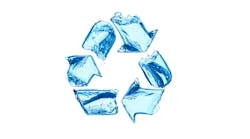Q: What is salinity in water? Is it good or bad?
A: Salinity means lots of different salts! It can be either good or bad.
Introduction
Salinity (dissolved solids) is an important aspect of drinking water quality that can be beneficial or harmful, aesthetically pleasing or a cause for rejection of the water. Distilled water, desalinated water and rainwater have minimal salt content. Seawater and brines have tens of thousands of parts per million (ppm) of salts, and typical drinking waters can have hundreds to well over 1,000 ppm, mostly less than 200 ppm concentration (ppm equals milligrams per liter of water). The problems are: How much is too much salinity? What are aesthetic issues? Are there any potential health consequences, and can it be managed at a reasonable cost?
What are the components of water salinity?
The basic chemistry definition of a salt is the reaction product of an acid and a base. So, for example, sodium hydroxide plus hydrochloric acid yields sodium chloride plus water (NaOH + HCl → NaCl + H2O).
Most salts encountered in drinking water are inorganic, but there are also organic salts; for example, methyl amine plus acetic acid yields methylammonium acetate (C2H3O2H + CH3NH2 → CH3NH3+ C2H3O2–). There are also mixed salts like sodium acetate.
Salts consist of paired anions and cations. The cation is positively charged because it has lost an electron; the anion is negatively charged because it has gained an electron. Some are individual element/ions, e.g. chloride, Cl– or sodium, Na+ ions; some are complex ions, e.g. ammonium ion, NH4+; and some have multiple charges, e.g. sulfate, SO4= . The pairing is necessary so that the net charges are balanced.
Some salts are ionized in water and some are not or partially ionized. Solid salts usually exist as crystals of several possible arrangements. Because water can be polarized, salts in water solution are "solvated," which means each ion is surrounded by a number of water molecules that locally neutralize the + and – charges. The oxygen ends of the water molecules surround the positive ions, and the hydrogen ends surround the negative ions; that is why many salts are soluble in water, which is neutral but polarized, but not soluble in nonpolar organic solvents like benzene. If a salt is soluble in water, it means that the solvation energy of the ions in solution is lower than the binding energy in the solid crystal.
Seawater and brackish water
More than 97 percent of the water on Earth is salt water. Over the millennia, salts on the land have been washed into the sea or accumulated in aquifers by extraction from the geology. The salinity of natural water ranges from rain at very low levels, to less than 100 mg/l in many fresh waters, to approximately 35,000 ppm in oceans, to more than 50,000 ppm of total dissolved solids in some confined and coastal seawaters, e.g. Arabian Gulf. A typical seawater could contain about 19,000 mg/l chloride, 10,500 mg/l sodium, 2,600 mg/l sulfate, 1,250 mg/l magnesium, 400 mg/l calcium, 400 mg/l potassium, 150 mg/l bicarbonate and 80 mg/l bromide — plus assorted lesser ions. A brackish water of about 3,500 mg/l to 10,000 total dissolved solids (TDS) could contain at least about 900 mg/l chloride, 750 mg/l sodium, 1,000 mg/l sulfate, 90 mg/l magnesium, 250 mg/l calcium, 10 mg/l potassium, 380 mg/l bicarbonate and lesser ions.
Salinity standards
Some individual ions, like lead or borate, have sufficient toxicity, so they have health-based standards or guidelines for drinking water. Fortunately, most of the mass of salinity in water has only aesthetic concerns, and there are recommended values such as TDS or hardness (mostly calcium and magnesium, plus some other cations like barium or strontium). Hardness is reported as calcium carbonate and classified in ppm ranges: Soft water, < 17; slightly hard, 17.1 to 60; moderately hard, 60 to 120; hard, 120 to 180; and very hard, > 180 ppm.
In the U.S., there are Secondary Maximum Contaminant Levels (SMCLs) that are actually federal guidelines for numerous ions based upon taste or other aesthetic reasons. For example: TDS = 500 ppm; sulfate = 250 ppm; chloride = 250 ppm; copper = 1.0 ppm; iron = 0.3 ppm; and manganese = 0.05 ppm. The World Health Organization (WHO) guidelines are similar.
Health issues
The human gut has regulatory mechanisms providing some screening of incoming ions and some selectivity of uptake. For example: Concurrent calcium intake depresses the uptake of lead ions, so drinking water (or milk) with calcium reduces lead uptake in children; bromide uptake is mitigated by chloride uptake. Water and dairy are often more efficient sources of minerals uptake, whereas there are dietary components (phytates) that reduce mineral uptake from vegetables.
Humans cannot tolerate excess salt intake. We lose salts by perspiration and in urine and feces. Consuming small quantities of clean seawater is not harmful, especially if the seawater is taken along with a larger quantity of fresh water. However, drinking seawater to maintain hydration is counterproductive. The gut cannot absorb water if the salt concentration is above about two percent because more water must be excreted to eliminate the excess salt, causing net dehydration. The human kidney regulates sodium chloride in the blood within a narrow range around 9 g/l (0.9 percent by weight), above that is toxic and can lead to seizures and heart arrhythmia. At that level there is equilibrium between water entering and leaving red blood cells; lower salt concentrations would cause excess absorption by the cells and bursting; higher concentrations would deplete water in the red blood cells. Excessive sodium loss can lead to hyponatremia, which can be fatal. Mineral imbalances can also have significant health consequences. The potential for kidney stone formation is debated.
There are also indications of positive benefits of minerals like calcium and magnesium in drinking water. The calcium body burden is about 1,200 grams, over 2.5 pounds. Calcium is efficiently absorbed from water and dairy at about 50 percent versus about 20 percent from nondairy foods, and that contributes to the daily calcium requirement of about 1,000 mg/day for bone and heart health. Magnesium, with a body burden of only about 25 grams, is also better absorbed from water and has numerous essential enzyme activity and heart health functions. Low serum magnesium correlates with metabolic syndrome that is a precursor to some diabetes. In addition, there are various water epidemiology studies that associate magnesium levels above about 10 mg/l with reduced cardiac-related mortality. So, it is possible that consumption of soft or softened water for a lifetime may be less desirable than consumption of harder waters, unless the diet provides sufficient available magnesium, especially from dairy.
Natural mineral waters
Many people consume mineral waters either because of perceived health benefits or desirable taste. Natural mineral waters are defined by the Codex Alimentarius. Maximum levels of certain potentially harmful minerals are usually similar to WHO guideline values: Antimony, 0.005 mg/l; arsenic, 0.01 mg/l; barium, 0.7 mg/l; borate, 5 mg/l; cadmium, 0.003 mg/l; chromium, 0.05 mg/l; copper, 1 mg/l; cyanide, 0.07 mg/l; fluoride, notify if > 1 mg/l; lead, 0.01 mg/l; manganese, 0.4 mg/l; mercury, 0.001 mg/l; nickel, 0.02 mg/l; nitrate 50 mg/l; nitrite, 0.1 mg/l; and selenium, 0.010 mg/l.
Taste considerations
Salts contribute tastes that are sometimes desirable and sometimes not, and they affect palatability. Distilled and desalinated waters usually have a "flat" taste. Salts are often added to improve palatability of bottled water and to reduce corrosivity in piped water. The U.S. SMCL for TDS is 500 mg/l. The WHO states that TDS at up to 600 mg/l is generally considered to have good palatability, and water becomes significantly and increasingly unpalatable as TDS exceeds 1.000 mg/l.
The California SMCLs are: TDS with a recommended consumer acceptance contaminant level of 500 mg/l, upper of 1,000 mg/l and short-term of 1,500 mg/l; chloride’s recommended level is 250 mg/l, upper is 500 mg/l and short-term is 600 mg/l; and sulfate has a recommended level of 250 mg/l, upper of 500 mg/l and short-term of 600 mg/l.
Excess salinity problems
Excess salinity is undesirable and can cause excessive scale formation in pipes, boilers and appliances, as well as interfere with the performance of washers for clothes and leave residues on glassware. Economic impacts include possible corrosion and reduction of the heat-transfer efficiency of boilers, which can cause premature failures of hot water heaters.
Water treatment
Salinity and TDS correlate with electrical conductivity, which is often used for tracking the performance of desalination treatment processes. Calcium and magnesium, and other divalent ions like barium, strontium and radium, are readily removed by conventional cation exchange water softening. Anions like fluoride, arsenate and nitrate can be removed by anion exchange treatment. Electrodialysis and electrodialysis reversal systems are also used in numerous commercial applications.
The universal treatment for salinity is membrane treatment related to desalination. Nanofiltration membranes are capable of removing multivalent ions more efficiently than monovalent ions, so they can be somewhat effective especially in non-seawaters. Reverse osmosis achieves removal in the 98-99 percent range in thousands of high pressure seawater desalination applications that can operate at rates as high as multimillion gallons per day. A rough estimate for production cost is about $4 per thousand gallons. Home POU technologies can reduce the salinity of domestic waters, but their water reject ratios are high because they operate at low water line pressure and with different membranes than the large scale units.
Some treatment processes increase salinity somewhat because of pH adjustments and some chemical treatment additives. Sewage has higher salinity than the source drinking water because of discharges and also human inputs. Potable water reuse projects often include a salts reduction stage, especially if the original drinking water has high salinity.
Conclusion
Salinity is a universal component of water to a greater or lesser degree because water is such a good solvent for ions. Fresh waters make up a minute portion of the Earth’s water — most is saline. Humans can tolerate limited amounts of salts in drinking water for reasons of health and palatability. Treatment technologies to produce drinking water from saline water and wastewater are widely available and numbers of applications are rapidly expanding. They are technology’s answer to the world’s need for universal access to fresh and drinkable water, for a price.


